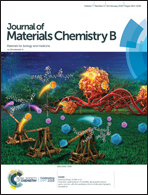Structural exploration of hydrophobic core in polycationic micelles for improving siRNA delivery efficiency and cell viability†
Abstract
Improving siRNA delivery efficiency often encounters a dilemma with poor or decreased biocompatibility for polycationic micelles. To address this dilemma, this work focused on a structural exploration of the hydrophobic core in amphiphilic polycationic micelles by preparing two amphiphilic polycations with block or random hydrophobic segments, poly(ethylene glycol)-block-poly(aminoethyl methacrylate)-block-poly(2-diamylamine ethyl methacrylate)-block-poly(2-diethylamine ethyl methacrylate) (mPEG–PAMA–PD5A–PDEA, PADE) and poly(ethylene glycol)-block-poly(aminoethyl methacrylate)-block-poly(2-diamylamine ethyl methacrylate-co-2-diethylamine ethyl methacrylate) (mPEG–PAMA–P(D5A/DEA), PA(D/E)). The properties of the two copolymers and their self-assembly micelles were characterized, including structure, morphology, size and zeta potential. Cytotoxicity, siRNA silencing efficiency and cellular uptake of PADE/siRNA and PA(D/E)/siRNA complexes were evaluated in HepG2 and MDA-MB-231 cells in vitro. The endosome escape and intracellular distribution of PADE/siRNA and PA(D/E)/siRNA in HepG2 cells were also observed by CLSM. Significantly, the results indicated that PA(D/E)/siRNA showed not only better gene silencing efficiency but also lower cytotoxicity, which may be attributed to the homogeneous morphology of the hydrophobic core of PA(D/E) micelles. Therefore, this work provides a new pathway to overcome the dilemma between siRNA delivery efficiency and biocompatibility for the development of efficient polycation carriers.



 Please wait while we load your content...
Please wait while we load your content...